27th October 2007
 Tuesday, November 20, 2007 at 08:20PM
Tuesday, November 20, 2007 at 08:20PM It was full moon last night, gloriously reflecting in the black river. We woke up to a misty dawn. Looking out over the Yatta Plateau, one could have been forgiven for thinking we were in the Aberdare highlands. The light was grey and dull, but nonetheless I took some photos of the Dik-diks feeding by our bedroom, standing up on their hind legs like gerenuk to reach especially juicy morsels. The Egyptian Goose family (still all six goslings) and the Dikkop pair were on the river at first light too, proudly in silhouette.
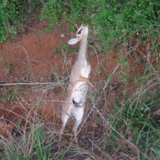
Dik-dik feeding (click to enlarge)

Egyptian Goose Family

Dikkops at Dawn
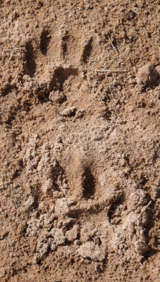
Leopard Pug Marks
There are fresh Leopard tracks on the beach this morning – probably the same small female whose pugmarks we see so often, but whom we never seem to see in the flesh. By the two distinctly different pugmark shapes, you can see how she extended her claws when her paw slipped into soft sand, and then retracted them again – just like a domestic cat does. I couldn’t resist photographing the white flowers of the tall reed-like riverine plants that line the beach here. We’ve also planted some on our balcony, in the flowerbed just outside our bedroom window. They’re doing quite well there, surprisingly. And while I was down on the beach, it seemed a shame not to grab a couple of shots of the doum palms – my favourite trees with their exquisitely formed fronds.
There were fresh elephant tracks on the road to the water tank this morning too. In fact, we heard the deep rumble of an elephant or two last night, so they probably passed up behind the house on their way to wherever. We heard lion and hyena too during the night.
I have noticed that even with the tiny amount of rain we have had so far, the delonix trees and even the commiphora trees have started to send out new shoots. (The lilies in my balcony flowerbed are accelerating too – you’ve probably noticed I’ve been photographing them daily to document their swift progress.) Many of the acacias are also flowering already, attracting dozens of butterflies during the day and hawk moths at night, all hungry for the sweet nectar. These dry country plants all react so quickly to any change in the weather, for they “know” that they only have a short time in which to flower and seed, before the onset of the next long dry spell; their reproductive cycles seem to be very short and their reaction time to climatic changes very fast. Amazingly, the Acacia Tortilis trees turn green five weeks before the rain – as such, they are a natural indicator of coming changes in the weather. The mighty baobabs started flowering a week ago, as if they too knew rain was on its way. The local Wakamba people, who are native to this area, say that when the baobabs start to flower, you know the rain is on its way. As if to prove the point, I took a shot of a flowering baobab in the rain the day before yesterday, just across the river from the house.
The frogs too start to call before the rain. They then become extremely vocal once the rain starts falling (a bit like weather reporters, very sure of themselves after the fact!) and by nightfall, the river becomes a vibrant chorus.
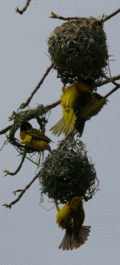
Click to enlarge
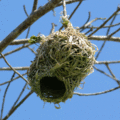
Click to enlarge
For some time, the Village Weavers (or Black Headed Weavers, whatever you prefer to call them) have been building nests in a young baobab tree, up behind the house. Although my photos today were taken in poor and uninteresting light, you can see from the construction of their nests, how they earned the name “weaver birds”. They have been benefiting from the grass growth under the trees near the house where we water regularly, as there is hardly any green grass anywhere else at the moment.
The wasps too have been busy for a few days, building their mud nests wherever they can get away with it in the house.
We had a great view of “our” mother and baby hippo today as they walked to the water’s edge and stood just ankle deep in the water. The baby still looks tiny beside the massive bulk of its mother. Just two minutes and then they were gone, back under the watery blanket of the river.
PM
The full moon did bring the rain – we had our first proper downpour today – eliciting a combination of great excitement and relief. I rushed around taking photos – far too many in fact – it’s easy to get carried away when the moment has been so long in coming.
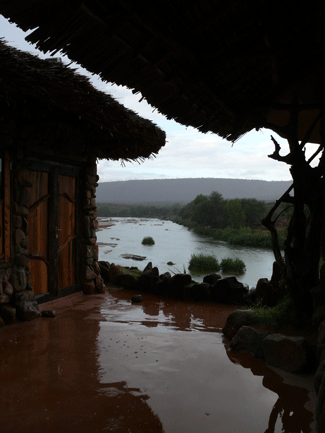
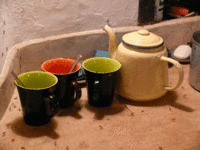
Bugs everywhere!
But in Africa, the delight that accompanies the first proper rain is short-lived, for within a few hours of the rain falling, you have to brace yourself for The Onslaught…literally millions of insects start hatching, and in the evening, hundreds of thousands are attracted to the lights, and you are literally invaded by bugs. It’s just something you have to put up with for a few day a year in this part of the world – it’s the one thing that makes you grateful for not having more rain – how easily swayed we are.
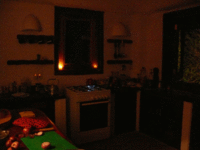
Cooking by candlelight...

A candle lantern: one of our most useful wedding presents!
Cooking dinner in a bug-infested environment can be quite a challenge, as you might imagine. I opted for candle light in the end, which seemed to work quite well, as after a while most of the insects left the kitchen in search of the brighter lights in the living room. We showered by lantern light too – with a bathroom which is wide open to the elements, it’s really the only way – and it looks oh so romantic too. I took some photos of the bug infestation outside our bedroom door – our aloe flowerbed beneath the balcony light had become totally overrun by flying ants and a staggering variety of other insects. If we hadn’t showered by candlelight, that’s how our bathroom would have looked within minutes...
Standing in the shower, I could see the moon reflecting off the river outside – it was so lovely, and as I was standing drying myself afterwards, I watched a hippo cross our beach in the moonlight – bugs or no bugs, this is a truly magical place.
See yesterday's Full Moon photos, alongside other images of the sun, moon & sky...
See more Dik-Dik and other Antelope photos...
View more photos of Weaver Birds and other avian residents of Kulafumbi...
Follow the story of our Egyptian Goose Family in pictures...
Take a look at my Track Stories Gallery, to see more wild animal footprints...
See more pictures of the insect invasion after the rain...
See pictures of Kulafumbi through the seasons: in the rain, and in the dry...





Reader Comments